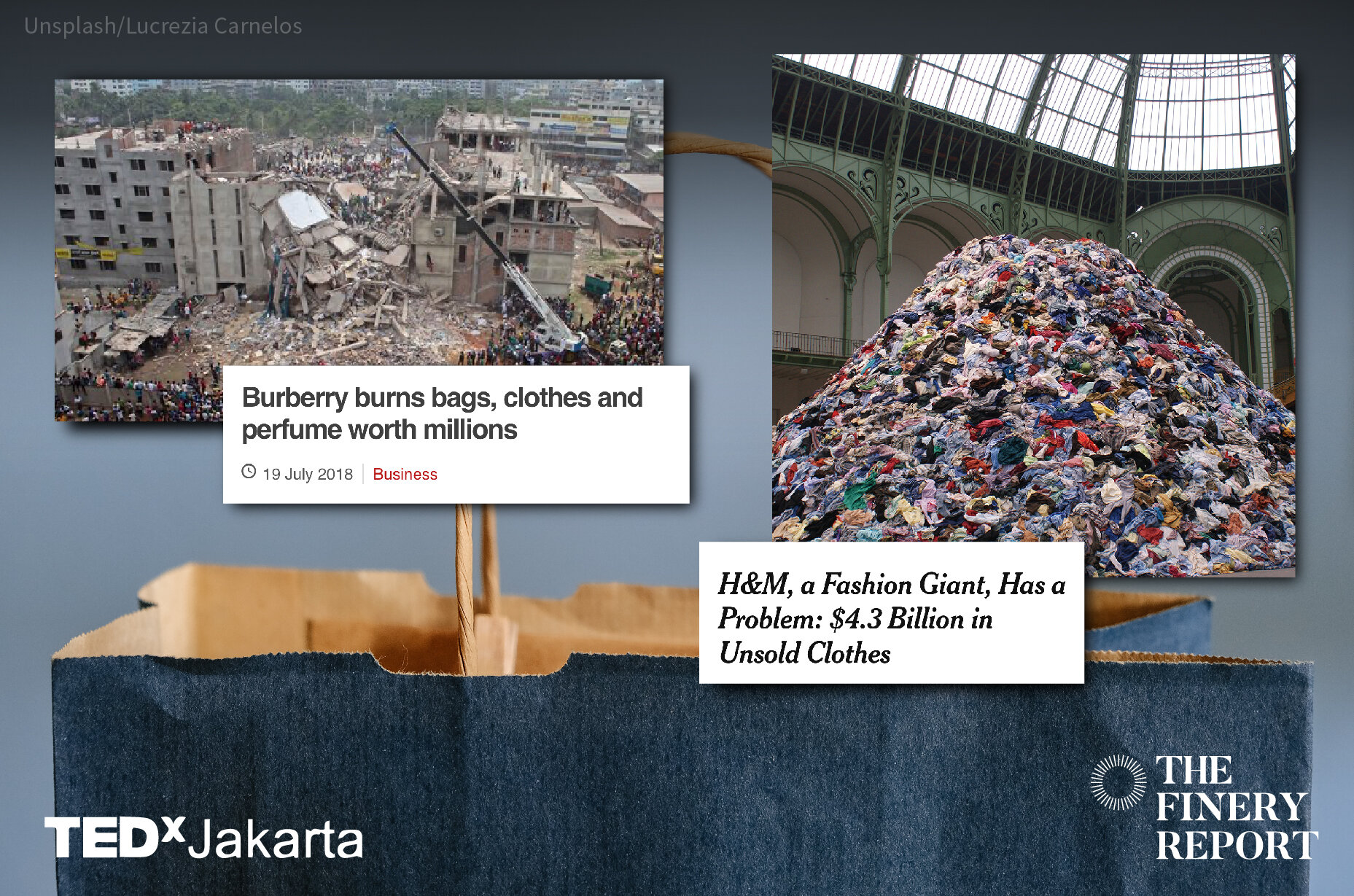The (real) definition of sustainable brand - Part 1. Environment
Read in Indonesian
Scientists have warned us. 17-year-old Greta Thunberg has voiced her concerns. Climate crisis will reach its peak in 2030. Some of the consequences are extreme weather shift, global warming and sea-level rise.
Fashion, one of the most polluting industries, has big contribution to both the economy and the climate crisis. In Indonesia, there is a growing list of fashion brands that have started using biodegradable packaging and resorting to eco-friendly material. The increasingly popular second-hand shop or thrift store is considered sustainable practice.
However, those only make up a small portion of sustainable practices in business.
Before claiming a brand as sustainable, one has to take economic, social and environmental aspects into account: in a sustainable business operation, they have to co-exist. For instance, if a brand uses eco-friendly materials but doesn’t fulfill the basic needs of its employees, it cannot be considered as a sustainable brand and vice versa.
The collapse of the Rana Plaza building in Dhaka, Bangladesh that killed more than 1,000 garment workers in 2013 was the result of unsustainable practices.
Moreover, sustainability effort doesn’t stop at using eco-friendly materials and biodegradable packaging. It has to tackle unethical supply chain, unsold inventories, fabric waste, operational waste and carbon footprint - also known as carbon emission - problems.
Last year, Burberry were caught burning off unsold inventories to keep the products from landing at discount racks as it could tarnish the brand’s reputation. Burberry is not the only luxury brands who destroy unsold inventories.
Richemont, parent company of Cartier, bought back $239 million (€203 million) unsold watches of its subsidiaries brands, Piaget, IWC and Vacheron Constantin in 2017. Some parts were recycled but some were destroyed.
Destroying unsold inventories is the fashion industry’s dirty secret. H&M and Urban Outfitters have been publicly criticised for burning off unsold clothes. Gap also claimed that they only destroyed damaged products. LVMH, too, destroyed products that its recycling facility partner cannot process.
From back-end operation, there are unethical supply chains, fabric waste from production and carbon footprint. Carbon footprint is the amount of carbon dioxide or other carbon compound produced from fossil fuels. It poses a big threat since it is invisible and it makes up vast majority of greenhouse gas emissions.
Every process and items that involve human activity have carbon footprint. Humans have carbon footprint too as we breathe out carbon dioxide. Burning off unsold inventories increases carbon footprint. Even thrift store has carbon footprint.
Calculating carbon footprint from a brand starts from supply chain to the manufacturing process, distribution, office operations, marketing and sales channel.
Supply chain, manufacturing process and distribution
Supply chain starts from where and how the material is produced, followed by transporting the materials to the manufacturing facility and distributing the finished products to the brand. If the product is imported, the carbon footprint from air freight or cargo can be quite high depending on the country of origin. This is why sourcing and producing locally could be more sustainable.
Office operation and warehouse
Offices also produce a significant amount of carbon footprint from air conditioners, light bulbs, water and electronics - unless the office uses solar panel power station. In fact, it isn’t limited to electronics. Every item we consume, including our diet, has carbon footprints because it also goes through similar operational process from supply chain, manufacturing, distribution, marketing and sales
According to multiple sources we gathered, switching on air conditioner for an hour generates around 680 to 840 grams of carbon dioxide. Meanwhile, daily office activity usually goes on for more than eight hours.
Then, there is also carbon footprint from meetings or events outside the office. This includes transportation and consumption.
Sales channel and marketing
One of the most overlooked areas on sustainable operations is the delivery service. Brands have to take carbon footprint from ride hailing applications like Go-Jek or Grab and delivery services into account. How much carbon monoxide does a motorcycle emit from a single trip?
The matter becomes more complex if the brand has a physical store since product distribution to and daily operations of the store create extra carbon footprint. The biggest culprit in the fashion industry lies in marketing strategies, such as hosting or attending an event.
Take fashion week for instance. Considering the scale of the event, the travel-including overseas flight-required to attend New York Fashion Week or Paris Fashion Week produces an alarming amount of carbon footprint.
A report from ODRE.com estimated that the travel to New York, Paris, London and Milan fashion weeks produces 241,000 tonnes of carbon dioxide a year. New York accounts for 37% of all carbon emissions, followed by Paris (28%), London (18%) and Milan (17%). That’s just travelling alone. Imagine the coffee cups, hairsprays, hotels and parties.
Last year, Coldplay frontman Chris Martin announced the band will not go on a world tour to promote their album until they can create a concert with no single use plastic and have it solar-powered.
Making sure that every aspect of sustainability runs smoothly is not an easy task. There is growing number of companies hiring sustainability professionals and establishing a sustainability department. Gucci holding company Kering went as far as to appoint British actress and environmental activist Emma Watson as its chief sustainability officer.
While Indonesia’s fashion industry hasn’t fully picked up the pace yet, designers or founders can start with being mindful of their materials and waste. A simple task, such as reducing daily paper consumption, is a step toward sustainability.
The goal is not about having every individual practice zero waste and zero carbon footprint perfectly; it is about having many people practice zero waste and zero carbon footprint as much as they can.
Visit our event page to find out more about Countdown by TEDxJakarta


